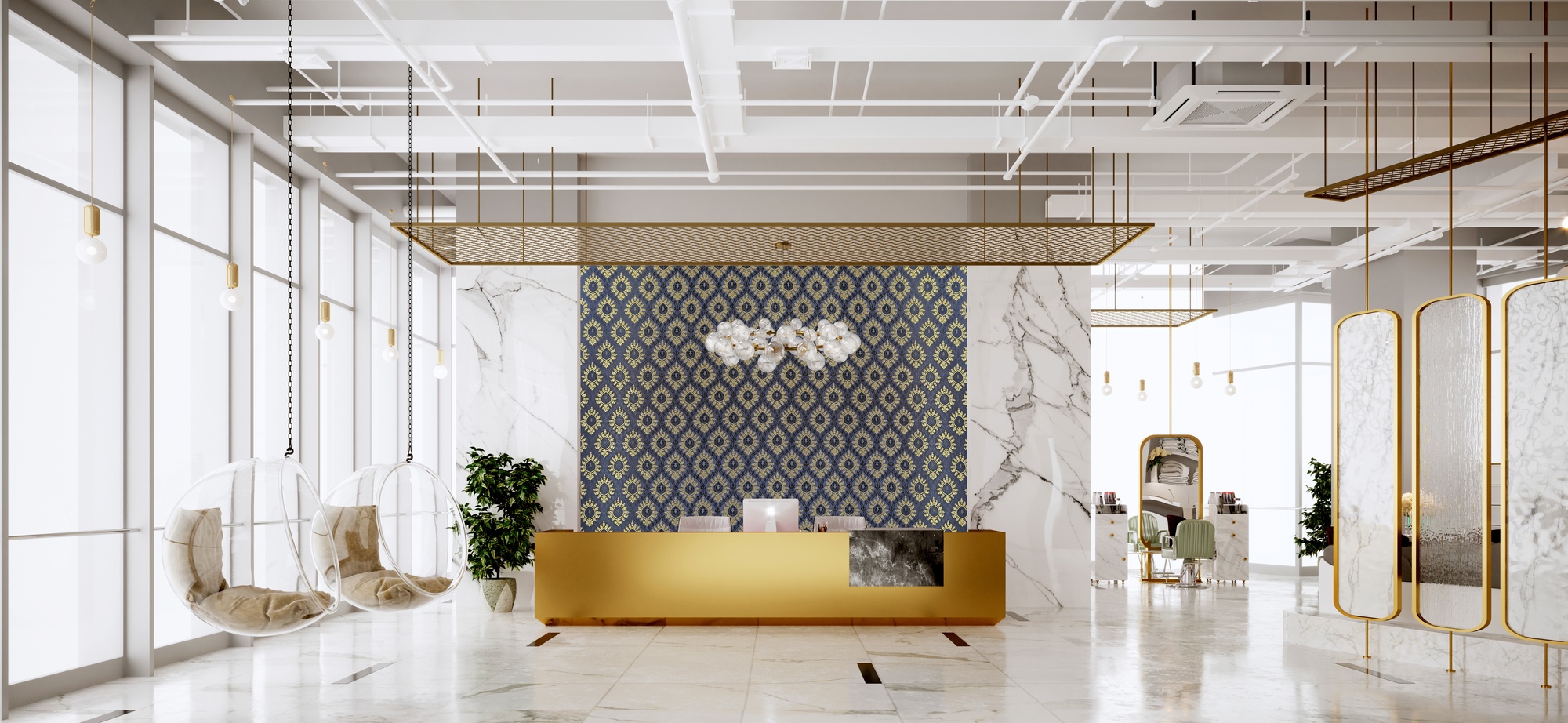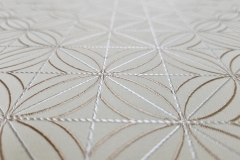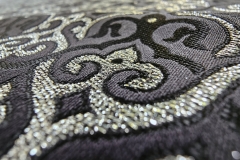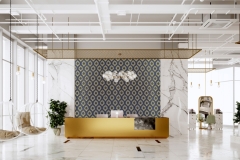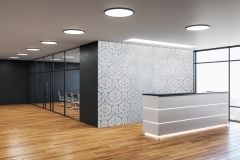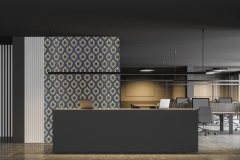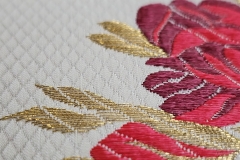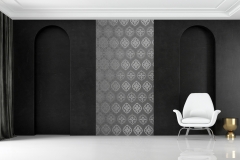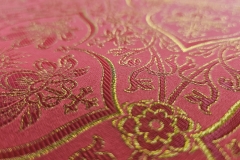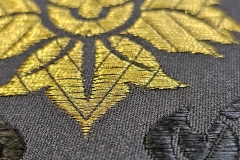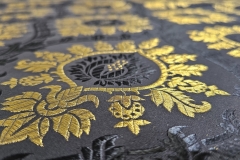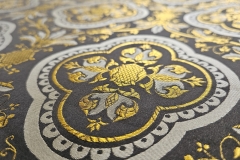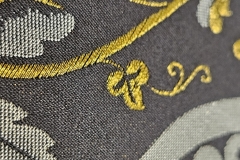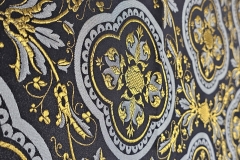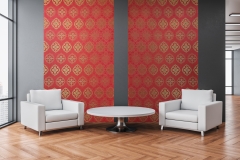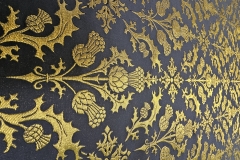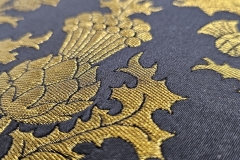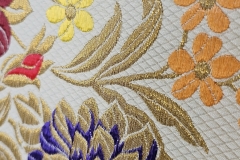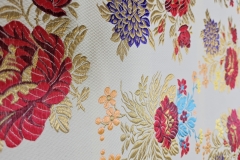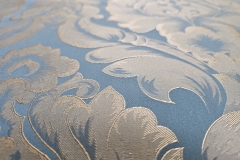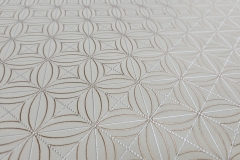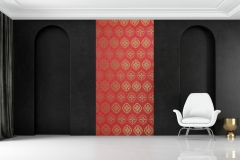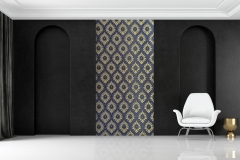Luxury Brocade Combined with an Acoustic Solution
Are you interested in modern trends in interior design? Do you prefer high quality to mediocrity? Then feel free to read on. In this article, we link the traditional role of fabrics in interiors, namely of luxury brocade, to its practical function: acoustic optimization of modern interiors. We will explain the basics of acoustics and show you how to add another very important yet invisible value to brocade fabric—acoustic absorption.
Why brocade?
Since time immemorial, silk brocade has been a symbol of luxury and wealth due to its unique properties. The threads of brocade contain metallic fibres, formerly silver or gold, and therefore have always been very visually attractive. The metallic fibres shimmer in brocade, which seems to become alive in changing light. When you walk past a brocade wall, you seem to be drawn to the changing reflections and tonality of the brocade pattern. When someone in brocade clothing passes by you, you will definitely notice them. This is also one of the reasons why brocade is sought by fashion and interior designers. Historically, brocades were made from precious silk, which gave them unusual softness, fineness and strength. In the 21st century, the term brocade is also used simply for textiles with a distinctively embossed pattern. The offer is wide…

Czech brocade manufacturer tested by generations
We cooperate with the Hedva Brocade Company, whose tradition dates back to 1890. Thanks to modern technologies, today’s brocade offers visual and technological advancements to its historical ancestors. It still retains its exclusivity and distinct look compared to ordinary textiles. Hedva Brocade Company can also weave made-to-measure brocades using your own design, custom motifs, initials or company logo.
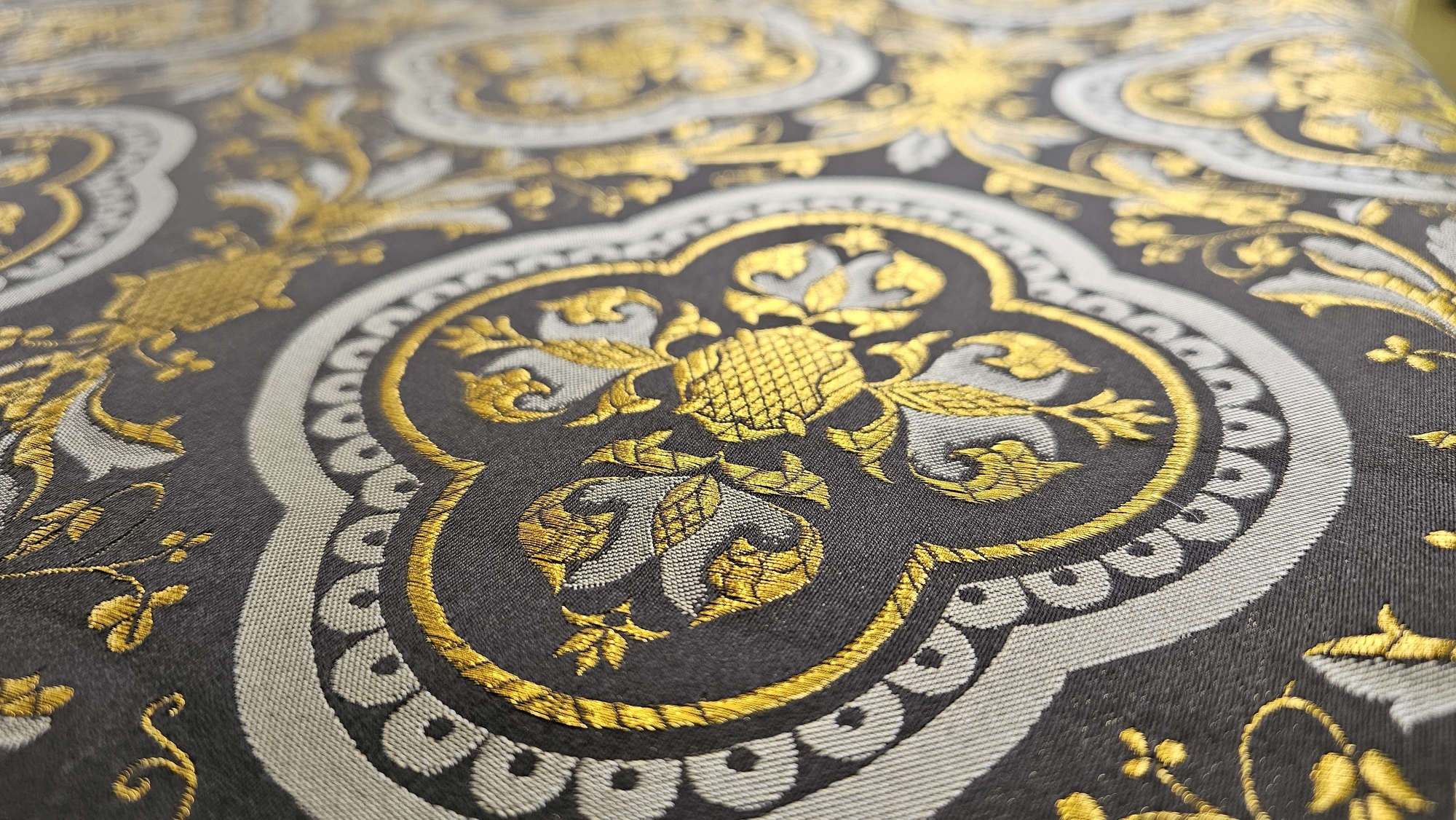
The live impression of brocade is very difficult to photograph or film. The most striking visual property characteristic of brocade is a kind of harmony of reflections of the metallic fibres, coupled with high contrast. This is very hard to describe, but even harder to photograph as dynamic tonalities cannot be displayed on a statically. Seeing the fabrics with your own eyes is necessary.
Combining history and modern trends
Why have brocade in the interior? Because it is exclusive and unique. In a modern 21st century interior, it will be a distinctive aesthetic feature the effect of which will vary depending on the lighting and on the viewing angle. In combination with Silentmax® acoustic panels, brocade will act as a luxurious acoustic element that absorbs noise and brings acoustic comfort.
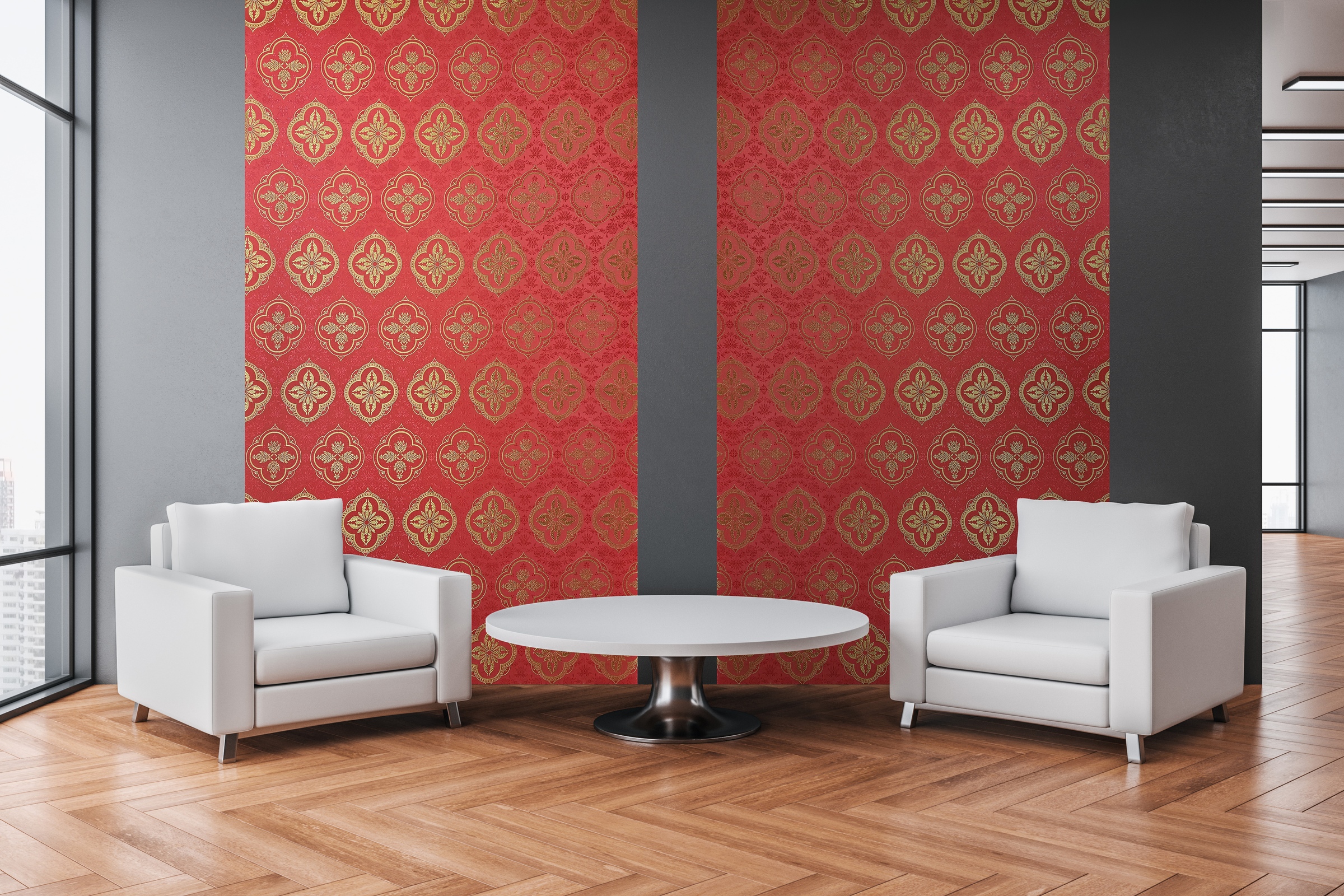
The brocade does not have to cover the entire wall, it can also form a strip, a visual divider or an accessory integrated in various ways, with the possibility to achieve visual, colour and aesthetic harmony. In an austere, minimalist modern interior, brocade will be the first thing that catches your attention, be it a private apartment, restaurant, reception or presentation area, lobby, conference hall, meeting room, or anything else.
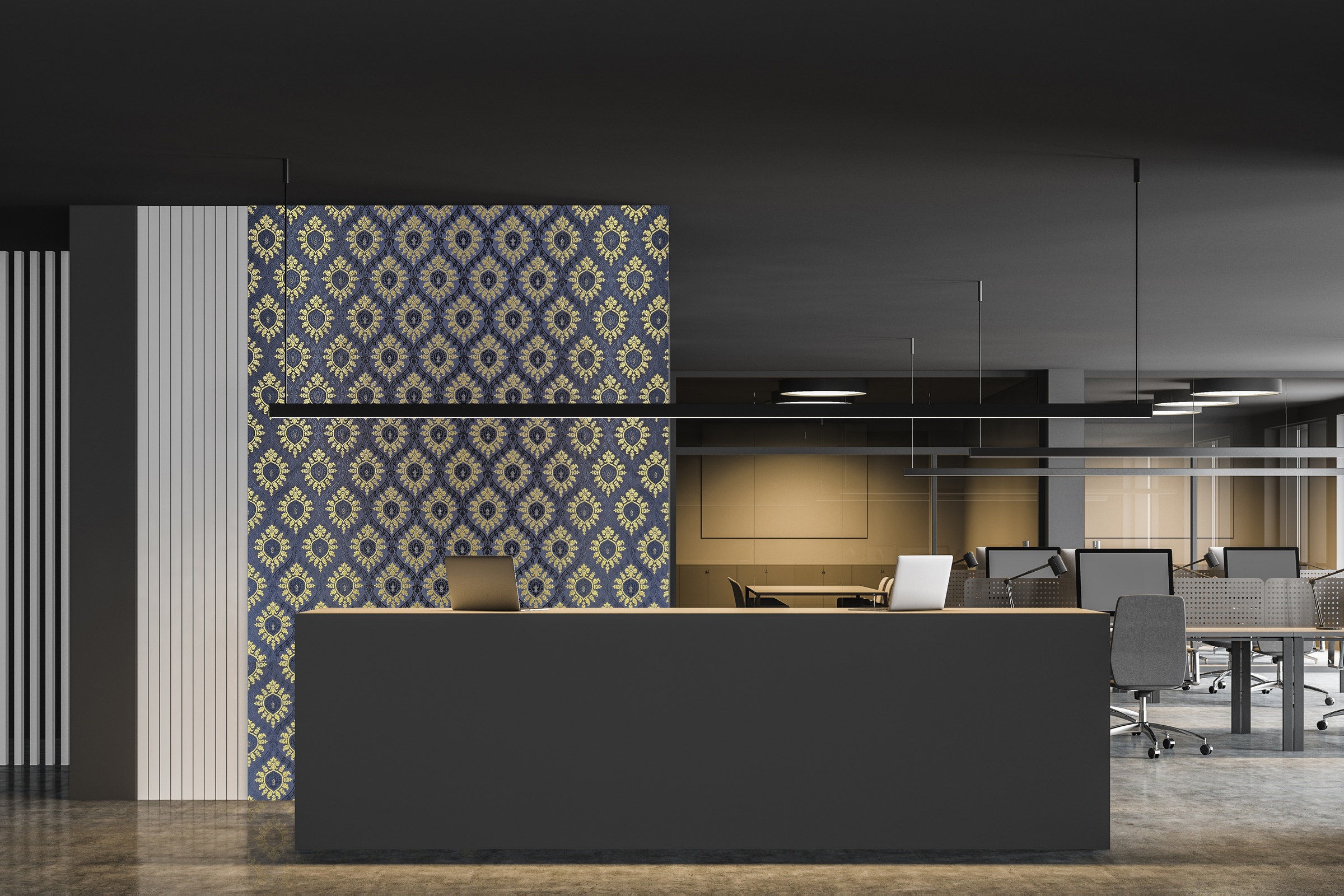
Acoustics is the key to peace and quiet
What is acoustics, how and why does it affect us and what is its connection to brocades?
Nature has given us, like most other mammals, two ears. Sound, or acoustic energy, we perceive with our hearing always, even when we sleep, when our other senses are at rest. Hearing is our most sensitive sense, with an incredible resolution (of pressure difference) of one to a trillion (1:1,000,000,000,000), which is why a logarithmic scale (dB) is used to measure loudness of sound. Hearing makes human communication effective. Thanks to the ears being a pair organ, and thanks to their respective distance, we can locate the source of sound in space. In an open environment, our brain can locate the distance and direction from which the sound is coming in a fraction of a second. This evolutionary advantage has helped us survive, so hearing is very important to us, despite the primacy of vision.
Would you like to learn more about acoustics? Read our articles on the physical behaviour of sound, the physiology and perception of sound, or go right on with room acoustics specificities for quality music listening.
Echo
For generations we lived in caves. Modern interiors, however, place much greater demands on overall comfort, even in terms of echo. Given the importance of human hearing, this basic acoustic parameter plays a key role in any interior. It determines how we feel; how we perceive the given space through our hearing, whether the interior feels pleasant to be in or the opposite.
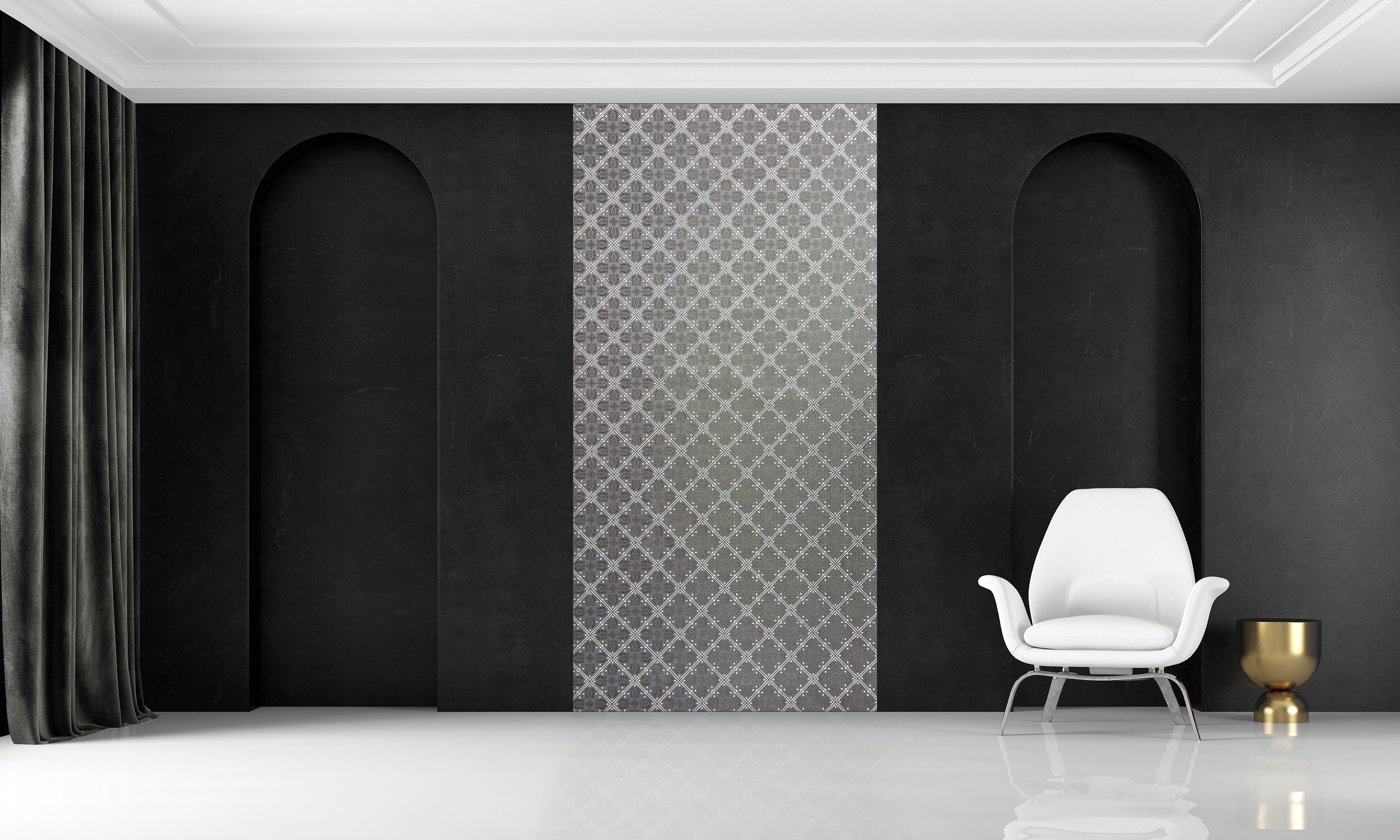
We’re going to talk about enclosed spaces, interiors where acoustic energy is reflected. Under the right circumstances, the reflections of sound last so long that it gives you a headache.
By acoustics, we can simply mean the behaviour of sound in the interior. The most important parameter of acoustics is reverberation time, or echo. It is the time during which acoustic energy is retained in a space before it dissipates. Sound travels through air at a speed of approximately 345 m/s. If you have experience hearing a noticeable echo indoors, at home or at work, what you perceive is the same noise reaching your ears 50 to 150 times. Try clapping your hands loudly. Sound expands spherically, similarly to the circles that form on water surface when you throw a rock in. Acoustic energy behaves similarly, but spreads in all directions. A wave of acoustic energy hits a wall, bounces off, hits a window or the opposite wall and bounces off again. Each reflection depletes some of the acoustic energy before the sound finally dies out. Too many hard, flat surfaces (which are all too common in modern interiors, for other good reasons) increases the echo (the time before the acoustic energy in the interior dissipates is long). On the other hand, soft breathable materials such as carpets, thick curtains, upholstered furniture and so on absorb acoustic energy and thus reduce echo.
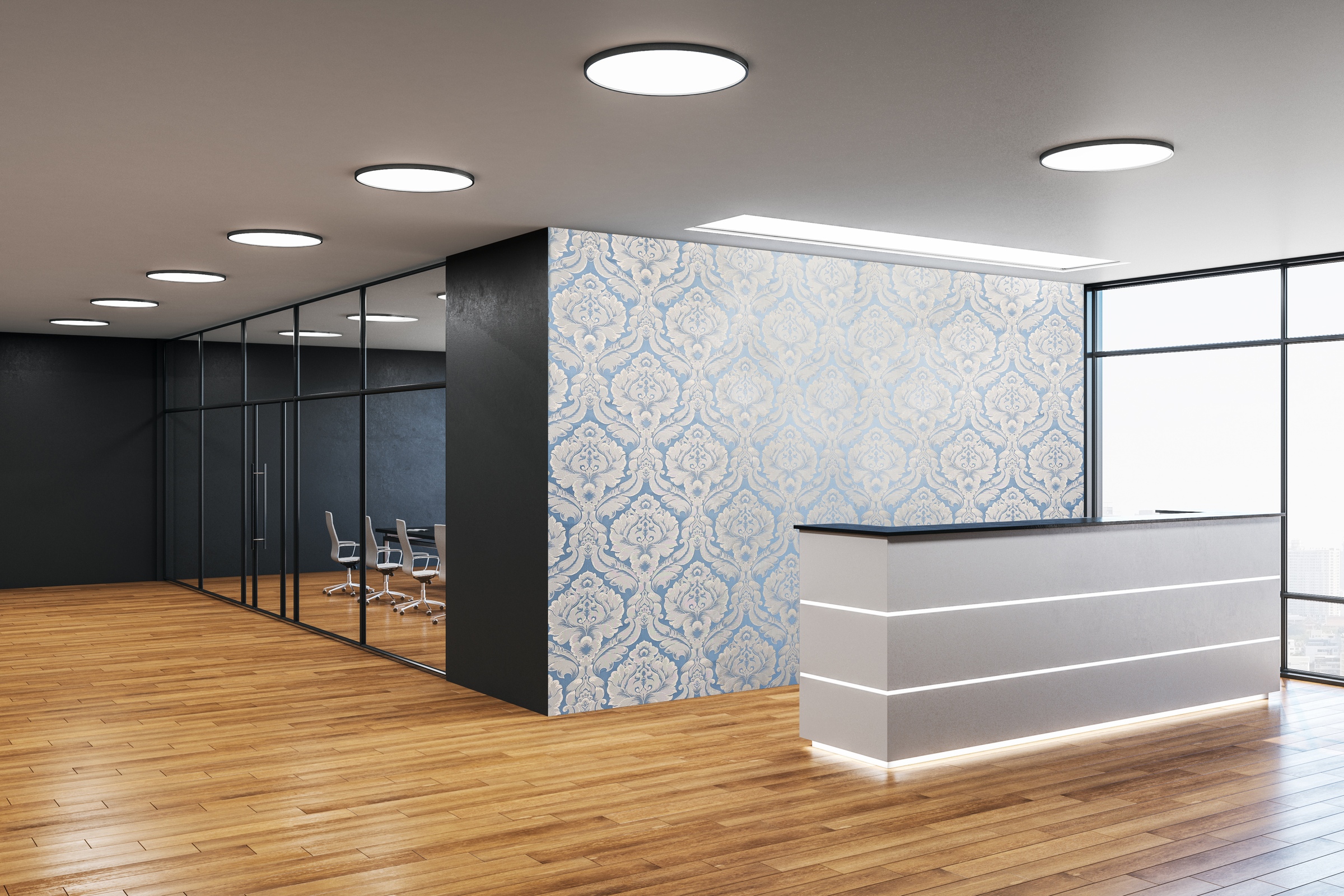
Control echo/reverberation with modern acoustic elements
What is the solution if you do not want to resort to carpets or curtains in your interior? Complement it with a modern, acoustically absorbing material such as Silentmax®, for example in combination with Czech brocade. You will get a surface with high acoustic absorption that also has a luxurious look and feel and is, quite literally, tailor-made for you. The acoustic and visual benefits will last for decades.
Sound behaviour in an enclosed space
Let us return to acoustics. Why is reverberation or echo important to us? We can certainly agree that noticeable, audible reverberation is unpleasant. You put a spoon on the table and you can hear the sound for 3-4 seconds before it fades away. We have personal experience from restaurants where you hear the conversation over at the next table more than the person sitting across from you. Trying to shout over everyone else, you leave with your vocal cords severely strained and your ears ringing—not really a place where conversation is easily attained. The negative experience, even if it was only subconscious, will influence your choice next time. The simple starting point is to be able to listen, and simply add acoustically absorptive material. If you want to go a step further, you can install an acoustically functional surface that is also visually appealing and in harmony with the interior design, its lines and colour scheme.
Where do problems with echo usually manifest themselves?
Schools, classrooms, meeting rooms, boardrooms. With a large enough echo, the speaker will have the tendency to shout himself over, even as others are trying to listen in complete peace and quiet. We listen to ourselves as we speak, and if we cannot, the result is the same as the restaurant conversation. The listeners then have to concentrate on every word to discern what is being said, which is of course exhausting. What is the point of having a meeting in a meeting room if you do not understand each other? Why go to a restaurant where we won’t understand each other? Have you built your dream house, but the interior feels cramped and uncomfortable? Clap loudly! If you hear the sound energy your palms make for more than a second, the acoustics need to be treated. Here our offer comes in; the first steps are simple and our solution is technically and aesthetically balanced, and has lasting benefits. The first mention of brocades is nine thousand years old and their value endures to this day.
Thinking of adding an exclusive combination of brocade and acoustic panels to your interior? The installation is very simple, any do-it-yourself enthusiast can do it. If you do not dare, our team will carry out your installation for you.
Luxury acoustic wall installation
Silentmax®
It is a modern, mechanically resistant material made from PET recyclate that has excellent acoustic absorption properties. The basic format of Silentmax® acoustic panels is 244×122 cm / 12 mm thickness. The size of the panels can be easily adjusted with a deburring knife, a cutout in any shape is also easy to make.
Silentmax® can be fixed to the wall by gluing (with liquid nails) or simply using dowels, the screw going through the acoustic panel. The brocade has a standard width of 160 cm. If the width of the acoustic wall is larger, we recommend cutting Silentmax® so that the area is symmetrically divided by 3 mm wide joints. The brocade can be easily folded into the joints. Panels can then be stacked with an aesthetically pleasing twist. Another possibility is to insert a gold or silver metal strip into the joint.
Brocade trim
Two people are ideally required for the job. Carefully measure the brocade fabric so that the brocade overlaps the Silentmax® panel by at least 15 mm and can be bent. The acoustically absorbent base you have prepared. Spray a thin layer of upholstery spray adhesive on the Silentmax®. Arrange the brocade over the panel, aligning the top edge so that the fabric overlaps the edge of the panel by 15 to 20 mm, center it carefully and pressing with the palm of your hand, smooth the fabric out against the adhesive. Fold the overlapping edges of the fabric behind the flexible acoustic panel.
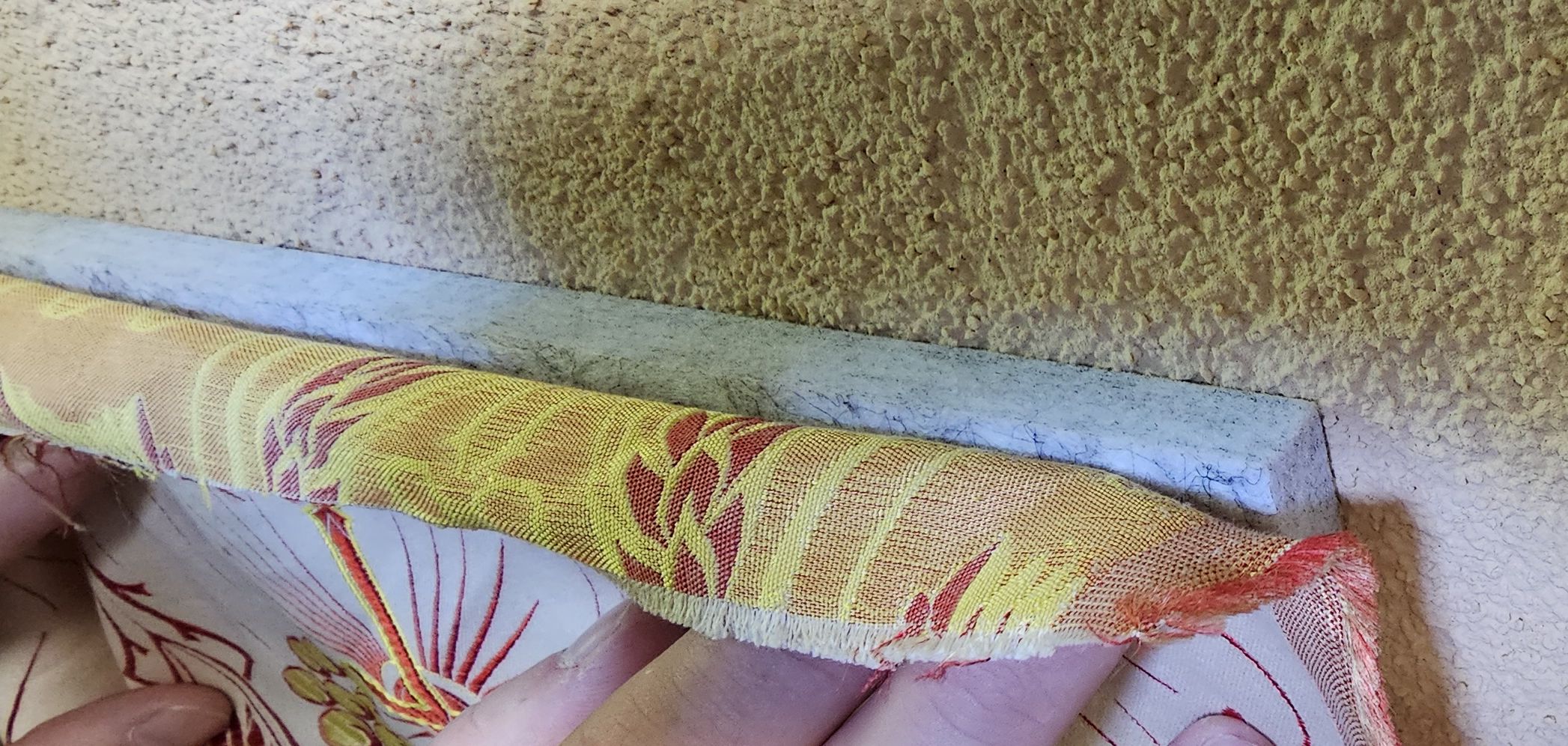
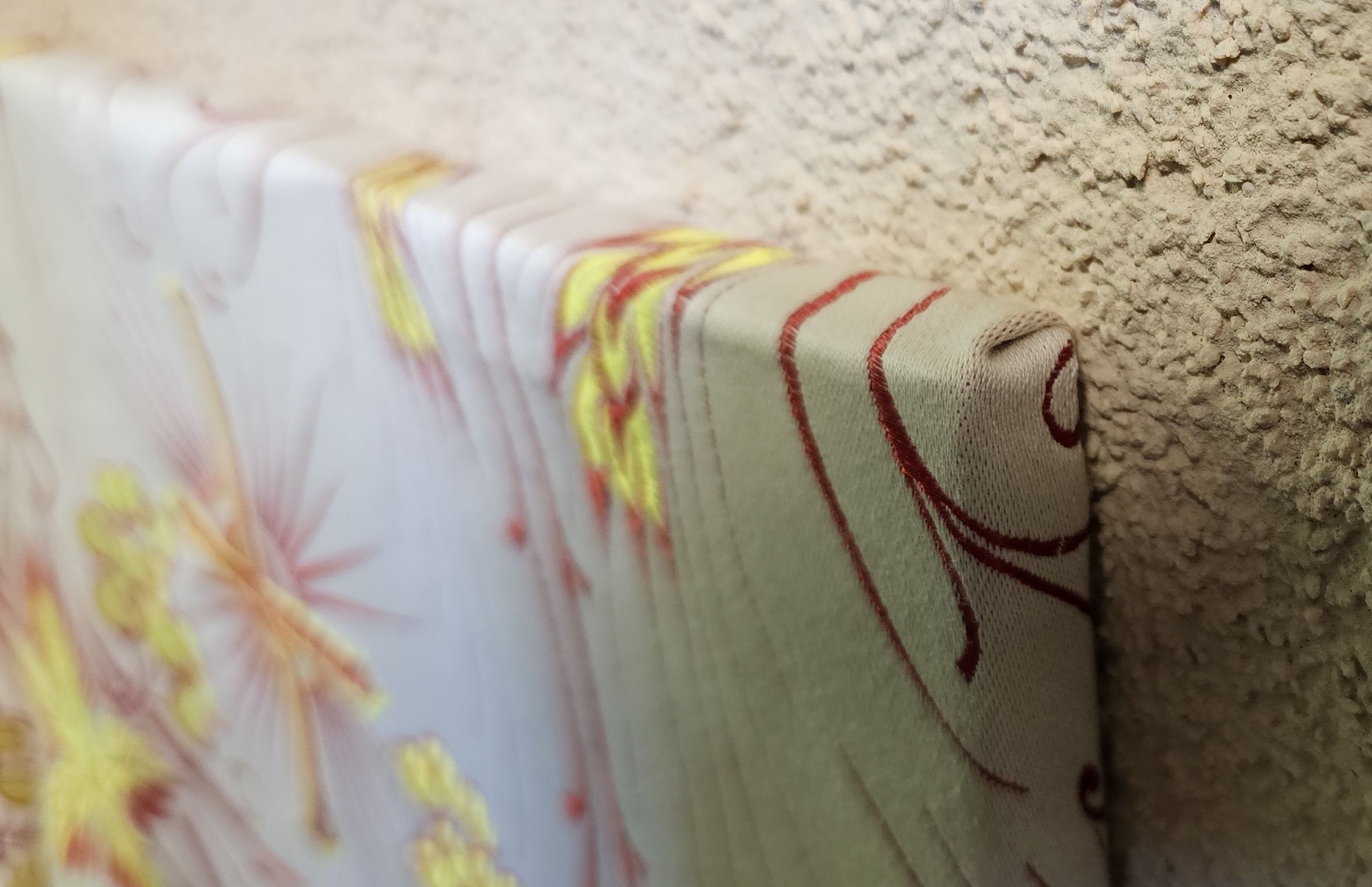
The prices
Silentmax® acoustic panel costs 88 €/m², prices of brocade range from 63 €/m² to 170 €/m² depending on the type of the base, the weight and pattern. If you order brocade acoustic wall elements directly from us, you get a free 20-year warranty. Acoustic comfort is definitely worth it.
What do we need from you? Please send us the dimensions of the space you are enquiring about (height x width x length), photos taken from all corners of the room, ideally using a wide lens so that we can get a realistic idea of the needs of your space and can suggest the most fitting, individual solution. You can direct your enquiries to rdacoustic@rdacoustic.cz.
You will get:
- Free acoustic solution consultation from professionals in the high-end audio sector
- Lasting acoustic comfort
- Exclusive appearance
- Durable, easy-care surface
- Twenty-year warranty
Newsletter
We'll let you know about our participation in audio shows, new reviews and products, new places to listen to your speakers, or new posts on our blog. We won't spam you.
